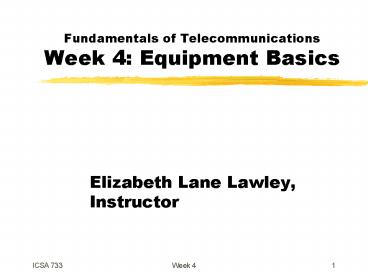Fundamentals of Telecommunications Week 4: Equipment Basics - PowerPoint PPT Presentation
1 / 22
Title:
Fundamentals of Telecommunications Week 4: Equipment Basics
Description:
Leased vs. Dial-Up Lines. Leased lines are a permanent circuit between two points ... the circuit can be a dial-up circuit again, passing through switching equipment ... – PowerPoint PPT presentation
Number of Views:195
Avg rating:3.0/5.0
Title: Fundamentals of Telecommunications Week 4: Equipment Basics
1
Fundamentals of TelecommunicationsWeek 4
Equipment Basics
- Elizabeth Lane Lawley, Instructor
2
Telephone Switching
- Process of connecting circuits to create a
continuous path from sender to receiver - Typically
- sending phone
- local loop wiring
- local telco office
- IXC (interexchange carrier)
- remote telco office
- remote local loop
- receiving phone
3
Switching Mechanics
- Circuit switches
- Store-and-forward switches
- Digital switches (uses multiplexing)
- Network switches (stand-alone, not integrated
into other equipment like computers or
multiplexers)
4
Leased vs. Dial-Up Lines
- Leased lines are a permanent circuit between two
points - They are wired around switching equipment, so
that fewer errors can be introduced - When not leased, the circuit can be a dial-up
circuit again, passing through switching
equipment rather than around
5
PBX
- Private Branch eXchange
- Switch (commonly called switchboard) where all
an organizations lines connect - Benefits
- cost savings
- call management/tracking ability
6
Fax
- Group 1-3 is analog Group 4 is digital
- Transmits with a recognizable tone, allowing
voice/fax switches - Scanner on sending side quantizes image to
generate a bit stream - Modem modulates bit stream into carrier signal
- Receiver demodulates, reconstructs image from
pixel info, and prints
7
Voice Mail
- Records voice data digitally, rather than on tape
- Can be stored on computers, forwarded easily as
needed
8
Client-Server Networks
- Hosts
- Mainframe
- Mini
- Micro
- Terminals
- Dumb terminals/asynch
- VT100 etc
- Smart terminals (synch)
- 3270 etc
- Micros emulating terminals
9
Alternate Approaches to Terminal Support
- Direct point-to-point links
- Multidrop line
- Multiplexer
- Integrated MUX function in host
10
Front End Processors
- Buffer data between slow terminals and fast
processor - Handles simple communication tasks
- Polling
- Code conversion
- Parallel/Serial conversion
- logging
11
Multiplexing
- Several data sources share a common transmission
medium, with each source having its own channel - Line sharing saves transmission costs
- Higher data rates mean more cost-effective
transmissions - Most individual data sources require relatively
low data rates
12
Direct Point-to-Point
13
Multidrop Line
14
Multiplexer
15
Integrated MUX in Host
16
Frequency Division Multiplexing
- Requires analog signaling transmission
- Bandwidth sum of inputs guardbands
- Modulates signals so that each occupies a
different frequency band - Standard for radio broadcasting, analog telephone
network, and television (broadcast, cable,
satellite)
17
Synchronous Time-Division Multiplexing (TDM)
- Used in digital transmission
- Requires data rate of the medium to exceed data
rate of signals to be transmitted - Signals take turns over medium
- Slices of data are organized into frames
18
Synchronous TDM and PSTN
- Used in the modern digital telephone system
- US, Canada, Japan DS-0, DS-1 (T-1), DS-3 (T-3),
... - Europe, elsewhere E-1, E3, ...
- Data rate of 1.544Mbps
- Uses PCM to digitize voice transmission at
8K/sec, frame length of 193bits
19
SONET Synchronous Optical Network
- Specification for high-speed digital transfer via
optical fiber - Rates from 51.84Mbps to 13.2Gbps
- Uses Synchronous TDM
20
Statistical Time Division Multiplexing
- requires digital signaling transmission
- data rate capacity required below the sum of
connected capacity - same concepts as synchronous TDM
- uses memory buffers to avoid loss of data
- widely used for remote communications with
multiple terminals
- similar to medium-sharing done by LANs
- Length of each character code based on
statistical frequency in text - Modified Group III Fax
- Encodes runs of black or white
- 4 million pixels to lt .5 million bits
- full page lt 1 minute _at_ 9.6kb/s
21
Port Sharing Devices
- Concentrators
- Used when there are more terminals than ports in
the front-end processor
22
Line Splitters
- Allow one set of modems to handle multiple
terminals communicating to host (via front-end
processor) - Polls each system for data to send across line
- Similar to multiplexing, but less complex































